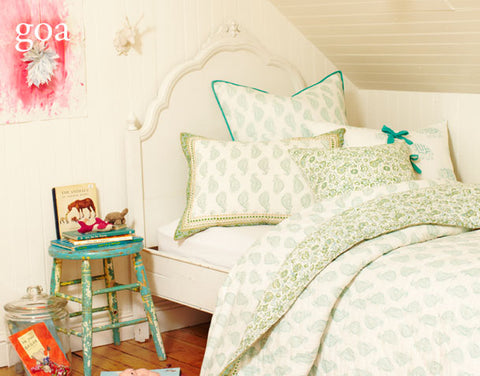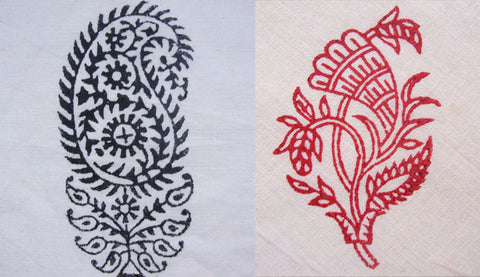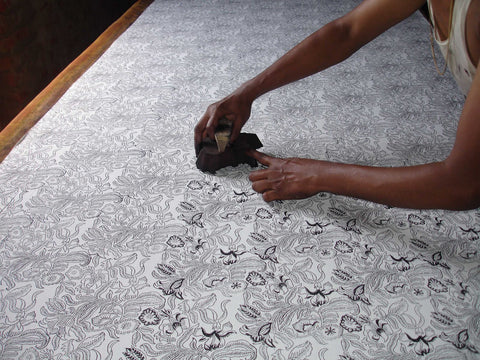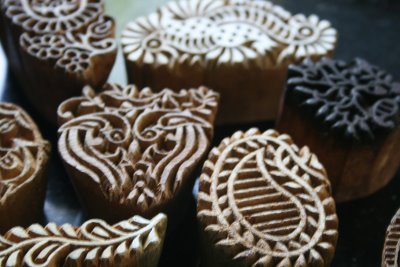Each village in Rajasthan boasts of the Chhipa caste engaging in block printing- be it mud resist or discharge or wax resist process. This stable tradition is still very much in fashion, despite the accessibility of modern techniques like screen-printing. The Chhipas hand over their craft skills down the generations, from parent to child, the expertise remains within the family.

Image Courtesy http://www.rikshawdesign.com
The beauty of the block print is heavily reliant on water sources; thus the commercial activities sprung near water resources- like Sanganer, Bagru, Akola, Barmer, Jodhpur, etc.
Over time, each centre for block printing in Rajasthan has developed its distinguished design style and techniques.

Goa collection from http://www.rikshawdesign.com
Sober, low toned colors and delicate lines, creating finer designs like the poppy, rose and lotus, usually against a white background, are well known characteristic of fabrics that are printed at Sanganer. While the motifs are conventionally big and bold in Bagru, with the dabu (resist-printing) and the dyeing process producing a reddish black shade- with wild flowers, buds and foliage providing inspiration to the printers of Bagru. In Jaisalmer, the printers use wax resists and create a dramatic wedding odhna called jajar bhat in red and black.
Sanganer
The village of Sanganer near Jaipur has been a major centre for very fine block-cutting and printing. Almost 500 years' old, Sanganeri printing gained high popularity in the 16th and 17th centuries in all European countries with its Calico prints and became one of the major exports of the East India Company.

Woodblock for textile printing, India, about 1900, 22 x 17 x 8 cm http://Wikipedia.com
Legend has it that it was probably towards the end of the 17th century that this art form developed here. Thanks to the constant wars with the Mughals and Marathas, many printers migrated from Gujarat to Rajasthan. Under the royal patronage, by the end of the 18th century this industry was fully developed in Sanganer.
The United Nations Industrial Development Organisation (UNIDO) in its report on the Jaipur hand block printed textile cluster, has mentioned, "Shades of black come out best after washing the cloth in the waters of Sanganer. Sanganer motifs are mostly floral based. Fine lines and intricate detailing are specialties of the Sanganeri style."

Dyeing of Sanganeri Printed Cloth is by use of natural colors (vegetable colors) as such, the finished cloth often emits very pleasant odour. Sanganer is famous for its Calico printed bed covers, quilts and saris. In Calico printing, the outlines are first printed, and then the color is filled in. Bold patterns and colors are popular. They are printed repeatedly in diagonal rows. Doo Rookhi printing is also famous here. In this technique, artists print on both sides of the cloth. Sanganeri prints are famous for their delicate floral sprigs.
This Tehsil of population 5,73,171 is one of the most prosperous amongst twelve Tehsils of Jaipur District. Sanganer town is well known world over due to its colourful block printed textiles and hand made paper. It is also in the excursion route for tourist. At present more than 315 Micro, Small and Medium size Sanganeri Printing units are operating at Sanganer. Total numbers of artisans vary between 1800 to 3000. More than 1200 families are directly dependent on these units. In addition, more than 3000 persons are indirectly involved in the business of Sanganeri Prints by providing supporting services like supply of raw materials, sale of finished products, production of blocks, designing of prints, garment making, packaging transportation and handling of exports. It is estimated that 25% population of Sanganer is directly or indirectly dependent on Sanganeri Print Industries for their livelihood.
The dyers and block makers came from Sindh and Punjab and settled here. The Chhipas, all Hindus, are followers of the renowned Marathi Saint Namdev. Almost every member of the ‘Chhipa’ family is involved in the washing, dyeing and printing of clothes. While, the printers are predominantly Hindus, majority of dyers and block makers are Muslims.
Water of the Saraswati River that used to flow graciously through Sanganer, was known for its special quality that used to bring out radiance from the natural dyed fabric.
Products
The principal items printed here include sarees, dupattas, salwar-kameez, bed cover, curtains, scarves, and printed yardages (running cloth material), etc. Both local and imported cloth material are used. At present,’ mulmul’ (cotton voile), ‘latha’ (sheeting fabrics) and cambric etc. are sourced from Jaipur.
Motifs
This elaborate work needs expertly cut mirror images blocks to print the usually asymmetrical Mughal style designs. Although Sanganer is well known for producing fine block printed textiles on off white or pastel backgrounds, today a wide range of textiles are produced with both dark and pale grounds.
A strong Mughal aesthetic dominates the region's printed sari designs. Borders and end pieces consist of repeated bands of undulated twines (bel) of various sizes. Fields are often covered with a repeat design varying from small simple dots or geometric shape to large complex buta and kalga.
Usually, a motif that is a blend of flower, bud and leaves or other forms such as keri (mango), pan (betel leaf), katar (dagger) or jhumka (ear-ring) is created. Interestingly, never was an animal used on these fabrics meant for costumes. Patronized by royalty, exclusive and fine printing in subdued colors, are a characteristic of the Sanganeri Print.

The Sanganeri Print is visible from small flower motifs like stylized sunflowers, narcissuses, roses, and other flowers of luxuriant foliage like daturas, rudrakshas, and arkas. On Sanganeri ‘chintz’ (printed cloth) usually, yellow, green blue (with different tones) are used as the background.
Various floral designs, geometrical and God figures are included in its prints. Sometimes, folk designs are also found. Finesse in flowers-petal designs, curves and delicacy are the prime specialties of Sanganer prints.

The curvature of flowers in the ’bootas’ is generally shown on the right side. Different types of flowers and plants are displayed in the form of ‘bel’ (a border) and ‘boota’ very naturally and in a really attractive manner. Some of the flowers used in the prints are roses, rosettes, lotuses, lotus bud, sunflower, lily, ‘champa’ ‘canna’ ‘nargis’, marigold etc.
Various other flower creations are also found in old Sanganeri prints. Other flowers used are locally known as ‘sosan’, ‘gainda’, ‘gulmehendi’, ‘javakusum’, ‘guldaudi’, ‘kachnar’, ‘jatadari lily’, ‘kaner’, ‘kanna’, ‘gullalla’, etc.

Apart from flowers, fruit trees of banana, dates, grapes pomegranate etc. have also been recreated in a very attractive manner. In some old prints figures of parrots and fish are also seen. In the traditional Sanganeri prints, the ground is in white or pastel shades with floral cones and sprays scattered with in symmetrical borders. Cloth printing blocks are usually made of 'teak' or 'seesum'. These dyes are printed on a textile by means of a relief covered block( a different block for each color). In India, the blocks are usually 23-30 cm (9-12") square in size.
Present Situation
In earlier times, the royal family of Jaipur was the chief patron of the craft. After Independence, the craft almost died till it was revived in the 70s owing to the patronage of prominent exponents like Kamala Devi Chattopadhyay, the person behind the cottage industry movement, Prabha Shah, Laila Tyabji, Pupul Jayakar and Faith and John Singh of Anokhi.
But faces still look grim. Faced with pollution charges and that too, only because of the screen printing industry, life is still dark.
The good news is that, because of the persistent efforts, Under Geographical Indication of Goods Registration and Protection Act.1999, Sanganeri Hand Block Textiles and Furnishings have been recognized to have a unique identity in manufacturing and in belonging to the area of Sanganer. Consequently sale of hand block or screen printed product from any other area as Sanganeri will be punishable under the law, thereby giving a new e trade and some 1500 artisans and about 5000 families indirectly or directly dependent on block printing.


23 comments
How can I take block print suits and Sarees in wholesale.. my no is 9717702113
I love the design colloction
Wooden block maker … Awsome
Iwant to purchase some block print materials for myselfcan you please guide me how to purchase them
In response to the question re: workshops-
You can contact Ms. Anella Jasuja in Andheri West/Mumbai for information re hands-on tour/ workshops in block-printing and use of natural dyes. The next tour/workshop is in November 2016, but there will be others.
The upcoming tour/workshop will include Sanganer and Bagru village.
email: anellaj@gmail.com